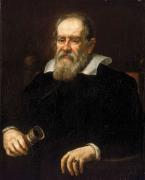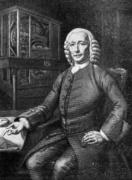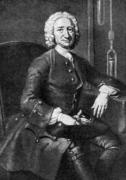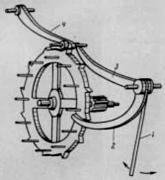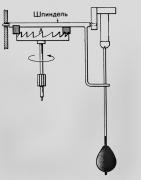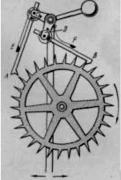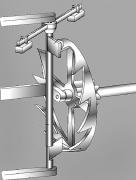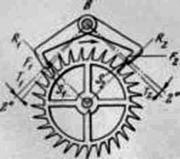On New Year's greeting cards image often put the clock. This is not surprising. Because the moment of transition from the old year to the new record using the device for measuring time - the clock.
More than two centuries the most accurate devices for measuring time were mechanical pendulum clocks. They became a symbol of his era. If the ancient myths of the world was like a living creature, in the XVII - XVIII centuries it was compared with the clock, but God creator called great watchmaker.
Today mechanical pendulum clocks have become exotic. Problems of improving long ceased to be subjects of dissertations or academic conferences. Their history is seen as a fairy tale - interesting, instructive but very far away from modern life.
The first mechanical clock - tower - was built in the XIV century. By XVI century, they had only one arrow - hour. Their mechanism of moving the weights that sank, and the course was regulated spindle mechanism.
This mechanism includes crown gear which rotates around a horizontal axis, vertically positioned spindle (rod with two blades arranged at an angle 90◦) and attached to the spindle horizontal balance - rod with placed on it loads that could move to adjust course hours . When the gear rotates, blades receiving jolts of teeth in one or the other side, so that balance has fluctuations, which determined the course of clock. Oscillation period depended on the moment of inertia of the system spindle-balance, strength shocks and friction. These factors are difficult to stabilize. In particular, the moment of inertia of the rocker because of its thermal expansion or contraction changed even during the day. Because of this spindle hours have low accuracy - no higher than half an hour a day, and they led up the sun.
About 1510 Nuremberg mechanic P.Henleyn first applied weights instead of spring steel spindle and created a pocket watch, which was even less accurate than the tower because the course depended greatly on the degree of winding springs.
A new era in the development of mechanical watches put the application in them the pendulum. This made the founders of scientific mechanics Italian Galileo Galilei (1564-1642) and Dutchman Christiaan Huygens (1629-1695).
In 1583 19-year H.Haliley while in Pisa cathedral noticed that the oscillation period chandeliers remains unchanged (that is isochronous) when the amplitude decreases. Later he studied that period pendulum is proportional to the square root of its length and is independent of its weight. He said this in his book "Conversations and mathematical proof concerning two new branches of science" (1638). We can assume that Galileo has repeatedly talked about how to use the pendulum to generate accurate clock, but to develop a mechanism started only at the age over 70 years - after already blind. For guidance Galileo continued to watch the development of his son and disciple Vincenzo Viviani, but it is unknown whether they managed to make the clock - there were only drawing on which later produced a model of the clock.
The trigger mechanism clock Galilei consisted of two brackets attached to the axis of the pendulum, ratchet wheels with pins and springs from the pin, which straighten the state did not allow the wheel to turn. When the pendulum is moving left, upper spring bracket raised, the wheel came back and struck the lower brackets. Pendulum receiving push, moving right upper spring clamp let go, ratchet wheel, turning one tooth stopped. Pendulum making one oscillation, back, and the cycle begins again.
Regardless of Galileo invented the pendulum clock H.Hyuyhens. In 1657, he received a patent on his watch the Netherlands, and in 1658 published a pamphlet "Watch", which described its design. In his clock Huygens used spindle mechanism that was different from the known fact that the crown gear rotates around a vertical axis, with loads of weights was not, and the spindle, located horizontally joined pendulum. As the pendulum oscillations occur under constant gravity oscillation period was stable, which provided significantly improve the accuracy of the clock compared to the spindle.
Spindle mechanism was less advanced than the mechanism proposed by Galileo. In particular, it can work only in the case of the pendulum with large amplitude oscillations. H.Hyuyhens observes that these oscillations are not isochronous. One could try to develop a new mechanism that would operate at low amplitudes of the pendulum, but Huygens chose the path of improvement spindle mechanism. As a result of experimental and theoretical research, he found that the pendulum is isochronous, driven by cycloid and got another series of results that significantly developed section of mechanics - dynamics.
In 1673 Huygens published work "Pendulum clock", which described the design of watches with the usual, cycloid and conical pendulum, the first time in the history of science considered the center of vibrations of physical bodies, the definition of acceleration of gravity using a pendulum, gave the theory of centrifugal force, described mechanical and geometrical properties of cycloid, explored evolute and involute.
The first pendulum clock with cycloid Huygens made the project master S.Koster. This clock was error of 5.10 seconds per day.
In 1675 Huygens simultaneously with Robert Hooke suggested using as a regulator oscillation system of "balance - spiral", which consists of wheels with massive metal rim, attached to the axle, and fine springs, one end of which is attached to the axis of the balance sheet and the second - to fixed support. This system proved too sensitive to temperature changes, because when the temperature has changed not only the length of the spring, but its elastic properties.
Inability to achieve a stable of the clock with a large amplitude of the pendulum, which is necessary for spindle mechanism has forced artists to seek means of the use of small amplitude oscillations. This means became anchor mechanism. It tines anchor (Anker - anchor means in German), which is on the axis of the pendulum, in turn within the undercarriage grip the teeth on the gears and regulate its rotation. The first clock with roof mechanism produced in 1671, Englishman William Clement (1640-1696).
Anchor mechanism improved in 1715, Englishman George Graham (1673-1751), who invented the anchor not free mechanism that is much less energy loss than Clement mechanism. Using this mechanism, Graham created a watch to within 0.1 second course. Dzh.Hrehem mechanism used in astronomical observatories to 1890 - almost 200 years.
Dzh.Hrehem several years studied the influence of various factors on the course of hours and concluded that a crucial role to temperature change. After determining the coefficients of thermal expansion of various metals, Graham invented the mercury compensation pendulum. The pendulum was filled with mercury, which has a coefficient of thermal expansion of the order higher than iron. When the temperature increases the length of the pendulum. However, the mercury rises in the tube and compensates for lowering the center of gravity of the pendulum.
Along with Graham on the issue of temperature compensation pendulum worked for John Harrison (1693-1776). In 1726 he designed the pendulum lattice of longitudinal and transverse iron rods brass. When the temperature expansion of iron rods through the length of the pendulum increasing. But the brass rod expands, distorted steel rods, compensating increase the length of the pendulum.
Dzh.Harrison created the first marine chronometer. This inspired his bill (law) of the British Parliament prize of 20 thousand. Pounds method of determining longitude with an accuracy of 0.5 degrees or 30 miles for the voyage to the West Indies (America) and back.
Harrison began to develop chronometer in 1726 and completed development of the first clock in 1735 clock was put in place two running springs. His progress was determined by two massive balances that fluctuated in opposite directions, thereby significantly decreasing the impact of ship movements to move the clock. Harrison also developed a new trigger mechanism, known as the "grasshopper", means automatic compensation for changes in temperature action balance springs, made substantial reduction of friction in the mechanism. This watch tested in May 1736 while sailing to Lisbon and back and received encouraging results.
The second, improved, Harrison clock made in 1739 at sea was not tested because England was at war with Spain and was a danger that the clock can fall into the hands of the enemy.
In 1741 Harrison began making his third maritime clock, but it only ended in 1757. Here, compensation of temperature changes in the elasticity of spiral and ball clock was used bimetallic compensation device that changed the length of the spring when the temperature changes. This watch is not experienced at sea. In 1759 Harrison produced a fourth marine clock. In it he used a modified spindle course and have used a number of improvements designed before.
In order to conduct testing on a journey with this chronometer 18 November 1761 on the ship to Jamaica "Deptford" set off from Portsmouth son William Harrison. After a 61-day journey around the clock behind by 9 sec. On the return journey the ship set off on Jan. 28, 1762 and arrived in Portsmouth March 26, 1762 watch during this time behind one minute and 5 seconds, which corresponded to the level of accuracy of 18 miles, which was much less than 30 miles - errors that permitted to obtain awards of 20 thousand. pounds. So Harrison solved the problem, which has put British parliament after 36 years!
However, the relevant authorities vvazhyly results inconclusive. Harrison paid only 10 thousand. Pounds and went on trial. They were successful, but the second half Harrison Prize received shortly before his death - only after its clock in the 1772-1775 biennium. Successfully used the famous James Cook while sailing the South Seas in the ship "Rezolyushen."
It is clear that the story did not stop to watch Harrison chronometer. Other craftsmen perfected mechanisms (only anchoring mechanism was invented more than two hundred!), Develop new materials - from close to zero coefficient of linear expansion (for pendulums) and the minimum value thermoplastic coefficient (for elastic elements), creating new types of clocks, such clocks .
In the XIX century. there were electronic clocks, pendulum oscillations which manages the electrical circuit in the middle of the twentieth century - electronic, based on counting the number of oscillations of quartz-resonator-term electronic circuit.
Today mechanical pendulum clock accuracy can not compete as electronic instruments for measuring time. But they retain the aesthetic value, and their history as part of the history of human civilization, will always remain a source of inspiring examples.



